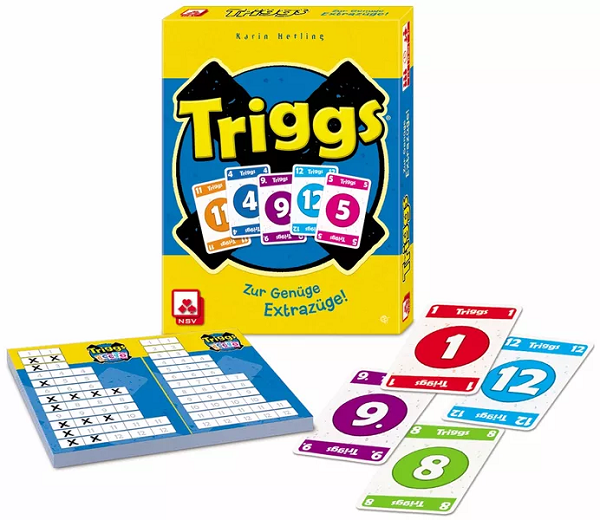Use Math, Odds, and Careful Planning in Card Game Triggs

With a little math and a lot of hand management, race to be the first to cross off all the boxes on your player sheet!
Published by NSV, Triggs is a light, easy-to-learn card game for 2-4 players with a 20-minute playtime.
Gameplay
The deck is shuffled, and each player is given five cards for their starting hand as well as a player sheet. Cards range from values of 1-12. The deck is then divided into three draw piles, two are placed face-up and the center one, which is the largest, is kept face-down. The size of the piles does not have to be exact.
Each player sheet has rows numbered 1-12, with the number of boxes in each row varying from two boxes to five.
On your turn, you choose one of three actions to perform and then it is the next player's turn. You can draw two cards: these can come from any of the three draw piles, but your hand size cannot exceed 10. Discard cards: you discard as many cards of a single value as you wish. Or you can cross off a box in one of your rows: to do this, you must discard a card of that row's value, or cards that add up to that value. You can cross off multiple boxes from the same row if you discard multiple cards of the correct value. You cannot discard cards of different values to mark off boxes from different rows. However, when you mark off the last box of a row, you get to mark off one box in any other row (this can cause a chain reaction if you then mark off another final box in a row). The first player to mark off all his rows wins the game.
If you ever have no cards in your hand at the end of your action, you draw five new cards from the face-down draw pile.

Review
Triggs is simple, with easy-to-learn rules, but some really interesting hand management and math mechanics at its core. Do you want to collect lots of the little numbers, as they’re more flexible to add up to a wider range of numbers, or use them now to mark off the lower value rows? Should you draw from the face-down pile and hope to get the exact number that you need? The hand limit also prevents you from just repeatedly drawing cards turn after turn.
You can also try and ditch cards to trigger the mechanism of drawing up to five for a new hand, but that can come with some uncertainty, especially later in the game when you might have already completed the higher-valued rows, making some cards useless to you.
At the start of the game, you’ll be marking off lots of boxes, but as the game progresses it becomes more challenging to hit the exact numbers you need. This leads to some close games and also means you need to consider your cards and the ways they can add up carefully.
There is no direct player interaction outside of possibly having someone else draw a card you were hoping for, and the race mechanism of trying to be the first to finish your sheet. But the turns are quite fast, and while there are interesting choices to consider, you typically know more or less what you want to do by the time it’s your turn.
More player sheets could have been included. The pad only comes with 20 sheets, although each one can be used four times. Still, this is such a speedy, fast game, and it's easy to find yourself playing several rounds of it — given that up to four players are supported, you can work through those sheets pretty fast if you enjoy the game.
Also, as of when this review is written, while the English language rules are online, there is not an English version of the box currently available or English rules included in the physical game. However, outside of learning the game, the gameplay itself is completely language-independent, making it a good choice in a group where not everyone might share the same language.
A fun, light card game Triggs is very portable and comes in a small box. The math element might also appeal to parents with kids, but the gameplay is enjoyable in its own right and it’s a fun little brain teaser while still being fun to play.
Pros: Hand management blends interestingly with the math mechanics of the game, fast turns
Cons: Not much player interaction, more player sheets should have been included
Disclosure: we received a complimentary review copy of this game.






